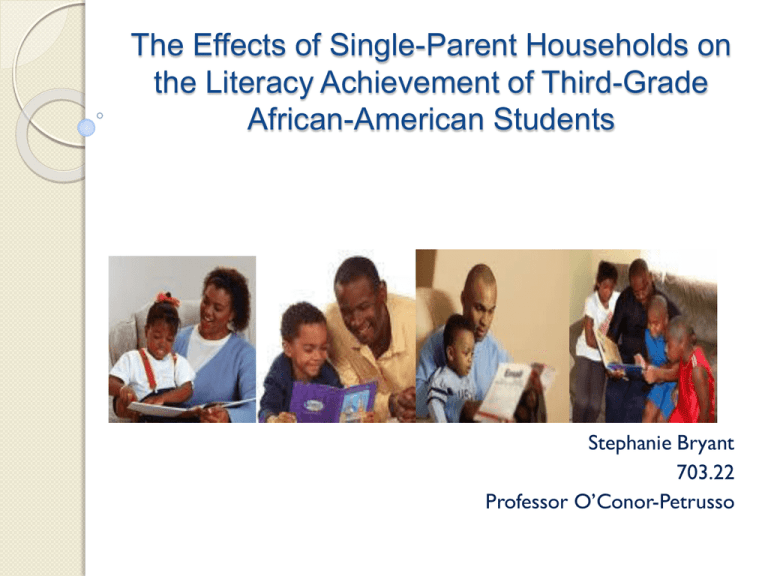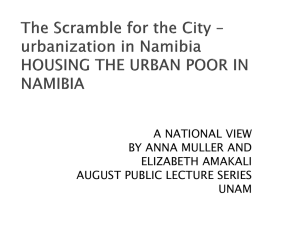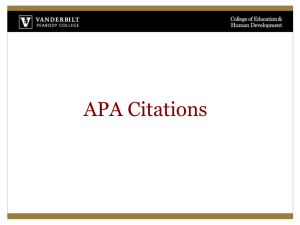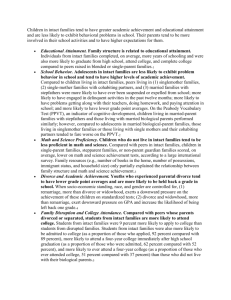703parentalinvolvement
advertisement

The Effects of Single-Parent Households on the Literacy Achievement of Third-Grade African-American Students Stephanie Bryant 703.22 Professor O’Conor-Petrusso Table Of Contents Introduction 3 ◦ Statement of the Problem 4 ◦ Review of the Literature 5 ◦ Statement of the Hypothesis 7 ◦ ◦ ◦ ◦ 8 Methods Participants Instruments Procedure Experimental Design Threats to Validity Data Analysis Discussion Implications References 8 8 9 10 11 12 16 17 18 Introduction There is a vast increase in the number of single-parent households. This change can be accredited to the many factors. Single-parent households are especially prevalent in the AfricanAmerican community. Statement of the Problem Children from single-parent households are faced with extra burdens that children from two-parent households do not have to face. In an effort to alleviate these stresses, adjustments need to be made. Review Of Related Literature Single-Parent Households Do Affect Student Achievement ◦ Pros: Parents who are involved in their student’s academic career help to increase the student’s academic achievement. Epstein & Dauber (1991) ; Zellman & Waterman (1998); Hawes & Plourde (2000); Senechal & LeFevre (2002, March-April) ; Ricciuth (2004, March/April) ; England, Luckner, Whaley, Egeland (2004); Amato (2005); Driessen, Smit, & Sleegers (2005, August); Jeynes (2005, Summer) ; Houtenville & Conway (2008). Single-Parent Households Do Not Affect Student Achievement ◦ Cons: Single-parent households do not play a role in student’s academic achievement, but other factors such as student’s motivational level play a role in student’s academic achievement. Iverson, Brownlee, & Walberg (1981); Dominia (2005, July); Debell (2008); Sojourner & Kushner (1997). Current Educational Strategies There are some strategies being implemented in schools to help single-parent households increase the academic achievement of their children. These include: ◦ Training parents on how to conduct reading instruction at home (Faires, Nichols, & Ricklman, 2000). ◦ Having teachers implement strategies such as maintaining a positive relationship with parents. having active parents spread the word to other parents to alleviate the educational barrier that African-American parents when dealing with their child’s teacher (Neuman, Hagedorn, Celano, & Daly, 1995 ; Trotman, 2001) . ◦ Having schools implement strategies that exhibit themes of empowerment, outreach, and indigenous resources (Abdul-Adil & Farmer Jr., 2006) . Statement Of Hypothesis H R1 ◦ Implementing the shared reading strategy with nine African-American third-grade students from non-intact (single) parent/guardian households over a six week period will help students at P.S. X increase their reading and writing achievement on the practice New York State English Language Arts Examination. Methods Participants ◦ Twenty-two third-grade students Sixteen AfricanAmerican nine AfricanAmerican students from non-intact households Six Latino American ◦ Working Class Families ◦ Public School in Brooklyn, NY Instruments ◦ Demographic Survey ◦ Literacy Surveys Student and Parent ◦ Two New York State English Language Arts Practice Exams Methods Cont’d Procedure ◦ In early February, consent forms were sent home to parents. ◦ In mid February, students were given a Literacy survey of their attitude towards Reading and Writing. Students were also given a pre-test using practice New York State English Language Arts exams to assess the needs of each student. ◦ From late February- early April, students were exposed to the Shared Reading strategy twice a week (Tuesdays and Fridays) for six weeks. Students from single-parents households were posed with comprehension questions by the action-researcher to aid in their understanding of the text. ◦ In late April, students were post-tested using a different practice New York State English Language Arts exam to see the effects of being exposed to the Shared Reading strategy had on their post-test scores. Experimental Design Pre-Experimental Design ◦ One-Group Pretest-Posttest Design ◦ Symbolic Design: OXO The study involves one group of students who will be pretested (O), exposed to a treatment (X), and post tested (O). Threats to Validity Internal Threats ◦ History ◦ Testing/Pretest Sensitization ◦ Instrumentation ◦ Morality ◦ Differential Selection of Subjects External Threats ◦ Ecological Validity ◦ Generalizable Conditions ◦ Pretest Treatment ◦ Selection Treatment Interaction ◦ Specificity of Variables ◦ Treatment Diffusion ◦ Experimenter Effects ◦ Reactive Agreements / Participants Effects ◦ Hawthorne Effect ◦ Novelty Effect Classroom Parental Structure Demographic Survey Question # 4 ◦ Parental Situation: (1) Intact: TwoParents/ Guardians Household (2) Non-Intact: One Parent/Guardian Household Parental Structure of Classroom X Two Parents/Gu ardians Household 44% Single Parent/Guar dian Household 56% Data Analysis Parents Reading with Students Every Night Relationship Between Parents Reading Every Night and Students' Self-Assessment of Reading Comprehension 4.5 Number of Students 3.5 3 Single-Parent/Guardian Household 2.5 Two-parent/Guardian Household 2 Student SelfAssessment of Comprehension 4 5 4 3 2 1 0 Students SelfAssessmentof Comprehension 0 1.5 2 4 Frequency of Parents Reading Every Night 1 0.5 0 1 2 3 Answer Selection 4 6 Linear (Students SelfAssessmentof Comprehension) With a correlational coefficient of 0.81rxy there appears to be a strong, positive correlation between parents reading to their children every night and the student's self assessment of their reading comprehension. Data Analysis Cont’d Reading an Hour Every Night Correlation Between Reading an Hour Every Night and Mid-Year Reading Scores 5 4 3 Series1 2 Linear (Series1) 1 0 -1 0 1 2 3 4 Mid-Year Reading Scores With a correlational coefficient of 0.52rxy, there appears to no correlation between students reading for an hour every night and their mid-year Reading Scores. Pre-test/Post-test Results The results of the pre-test depicted a classroom average of 55% for students from single-parent households and 57% for students from two-parent households. ◦ The post-test depicted a classroom average of 80% for single-parent households and 75% for two-parent households. ◦ The range of scores is 50%-75% for both household structures. The range of scores is 50%-100% for both household structures. This represents an increase of 25% for students from single-parent households and 17% for students from two parent households after being exposed to the instructional strategy. Discussion After being exposed to the instructional strategy, all students had an increase on their post-test. ◦ This finding adheres to the available research that parental involvement does affect student achievement. Students from single-parents households had a slight advantage over those from two-parent households. Comprehension questions posed mirrored classroom reading strategies (Faires, Nichols, & Ricklman, 2000). Regardless of the household structure, all students benefit from additional reading they were exposed to. Implications The results of this study suggest the need for the following implications : ◦ a need for studies at the elementary level. ◦ a need for a larger sample size. ◦ more longitudinal studies References Amato, P. (2005). The impact of family formation change on the cognitive, social, and emotional well-being of the next generation. Retrieved on October 3, 2009 from ERIC database. (ERIC Document Reproduction Service No. EJ795852). DeBell, M. (2008). Children living without their fathers: Population estimates and indicators of educational wellbeing. Social Indicators Research, 87(3), 427-443. Retrieved October 3, 2009 from Education Full Text database. Dominia, T. (2005, July). Leveling the home advantage: Assessing the effectiveness of parental involvement in elementary schools. The Reading Teacher, 51(2), 108-120. Retrieved September 25, 2009, from Education Full Text database. Driessen, G., Smit, F. & Sleegers, P. (2005, August). Parental involvement and educational achievement. Taylor &Francis, Ltd., 31 (4), 509-532. Retrieved September 25, 2009, fromhttp://www.jstor.org/stable/30032581. England, M. M., Luckner, A. E., Whaley, G. J. L. & Egeland, B. (2004). Children’s achievement in early elementary school: Longitudinal effects of parental involvement, expectations, and quality of assistance. Retrieved September 17, 2009 from ERIC database. (ERIC Document Reproduction Service No. EJ685033). Epstein, J. L. & Dauber, S. L. (1991). School programs and teacher practices of parent involvement in inner-city elementary and middle students. Elementary School Journal, 91(3), 289- 305. Retrieved October 26,2009 from Education Research Complete database. Hawes,C. A., & Plourde, L. A. (2000). Parental involvement and its influence on the reading achievement of 6th grade students. Reading Improvement, 47-57. Retrieved September 25, 2009 from Education Full Text database. Houtnville, A. J., & Conway, K. S. (2008). Parental involvement, school resources and student achievement. Retrieved September 18, 2009 from ERIC database. (ERIC Document Reproduction Service No. EJ792701). Jeynes, W. H. (2005, Summer). The effects of parental involvement on the academic achievement of african-american youth. The Journal of Negro Education, 74(3), 260-274. Retrieved September 25, 2009, from http://www.jstor.org/stable/40027432. Iverson, B. K., Brownlee, G. D., & Walberg, H.J. (1981). Parent-teacher contacts and student learning. Retrieved November 6, 2009, from http://www.jstor.org/stable/27539847. References Cont’d O’Connor-Petruso, Sharon. A. (2010, February 18). Descriptive & Inferential Stats, Analyses, Threats, & Designs. Presented at an Ed 703.22 lecture at Brooklyn College. Ricciuth, H. N. (2004, March/April). Single parenthood, achievement, and problem behavior in white, black, and hispanic children. Retrieved September 18, 2009 from ERIC database. (ERIC Document Reproduction Service No. EJ698473). Senechal, M., & LeFevre, J. (2002, March-April). Parental involvement in the development of children’s reading skills: A five year longitudinal study. Blackwell Publishing, 73(2), 445-460. Retrieved September 21, 2009, from http://www.jstor.org/stable/3696368. Sojourner, J., & Kushner, S.N. (1997, March). Variables that impact the education of african american students: Parental involvement, religious socialization, socioeconomic status, self-concept, and gender. Retrieved November 9, 2009 from ERIC database (ERIC Document Reproduction Service No. ED410326). Zellman, G. L., Waterman, J. M. (1998). Understanding the impact of parent school involvement on children’s educational outcomes. Retrieved October 3, 2009 from ERIC database. (ERIC Document Reproduction Service No. EJ571135).









